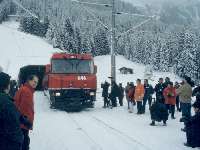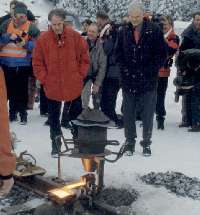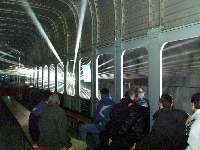
RhB
Vereina

On November 19th, 1999 the network of the Rhaetian Railway has been extended approx. 22 kilometers for the first time since 1914. On this day the 19.1 km long Vereina tunnel was opened officially. It connects the Prättigau with the lower Engadine. The line, which runs from (Landquart-) Klosters to Sagliains (-Scoul) is called the Vereina line. In the following text only the section Klosters- Sagliains is described. You can find information about the other parts of the line under the "Main network" section.

The plans for building the connection existed since the 1970's. It was decided in 1984 not to renew the Flüela road and to build a railway tunnel with car transportation instead. This decision of the political authorities of Graubünden was supported by a clear majority of the population. After the permission of the plans by the Federal Office for traffic was given in 1988 it still needed three years due to legal argument. But on April 18th, 1991 the first cut of the spade took place.
The project consists of several sections:
|
Crossing station Fuchsenwinkel |
With this siding the traffic Landquart-Davos and Landquart-Scuol becomes possible in the single track line. |
| Klosters station | Klosters has the line directing center for both lines Klosters-Sagliains as well as Malans-Davos Wolfgang. The station of Klosters is now an important railway junction and had to be developed accordingly. |
| Landquart bridge | The new double-track bridge over the river Landquart was already in operation since 1993. The 6,200 tonne heavy reinforced concrete bridge was built 10 meters up river during the normal railway operation. In a spectacular operation it was shifted to its current location. |
| Zugwald tunnel | Shortly behind the Landquart bridge the Vereina branch enters the 2,172 m Zugwald tunnel. This tunnel leads with a gradient of 4% upward to the car loading station Selfranga. The Zugwald tunnel is in operation since 1995. |
|
Auto loading station Selfranga |
No railway station for passenger, only for cars. Direct connection by road to Klosters-Davos. In 2005 the road will link directly to the 4,5 km long Gotschna road tunnel which will by-pass Klosters in future. |
| Vereina tunnel | The 19,042 m long Vereina tunnel is the main item of the line. It rises from Selfranga with a gradient of 1,48 % up to culmination point 1,463 m above sea level. Than it falls with a gradient of 0,48 % downwards to Sagliains. Basically the tunnel is single-track. In the portal areas and in the middle of the tunnel there are 2 km long double-track sections. Nearby the south portal the 277 m long tunnel Sasslatsch II opens a branch line to the upper Engadine toward St. Moritz. |
| Sagliains station | Car loading station station with direct connection to the road Scuol-Zernez. Railway junction for passenger exchange between the trains Landquart-Scuol and Scuol-Pontresina. The station was built using the outbreak material from the Vereina tunnel. |
The first building site was the replacement of the old Landquart bridge
in Klosters by a new double- track bridge. This made it possible to
start the construction works at the Zugwald tunnel without disturbance
 of the railway line Klosters-Davos. The tunnels connects the station of
Klosters with the car loading station Selfranga. Because the portal
areas consist of loose rock, these were built with the so-called Jetting
procedure. After 300 m a cave was broken off, where the tunnel drilling
machine was assembled. The completition of boring took place in November
1994. After its completition the building site Vereina North could be
reached on rail.
of the railway line Klosters-Davos. The tunnels connects the station of
Klosters with the car loading station Selfranga. Because the portal
areas consist of loose rock, these were built with the so-called Jetting
procedure. After 300 m a cave was broken off, where the tunnel drilling
machine was assembled. The completition of boring took place in November
1994. After its completition the building site Vereina North could be
reached on rail.
The building of the Vereina tunnel was made from two building sites: in the north from Selfranga and in the south from Sagliains, being situated between the municipalities Susch and Lavin. On both sides 2 km of double- and triple-track portal areas were broken off in a conventional way using explosives. On the north side the tunnel drilling machine, which was already used in the Zugwald tunnel, started at km 2,123. On the south side the classical method was used. On March 26th, 1997 the breakthrough was celebrated on tunnel meter 7,376, approx. six months ahead of schedule. After the breakthrough a 2 km long central siding was broken off. This is used for train crossings on the otherwise single-track tunnel. The technical completion was made in rapid time, on December 10th, the tracks from north and south were interconnected.
After the breakthrough a 2 km long central siding was broken off. This is used for train crossings on the otherwise single-track tunnel. The technical completition was made in rapid time, on December 10th, the tracks from north and south were interconnected.
After completion extensive tests were made with the new car
transportation trains. These lasted up to November 15th, 1999. Finally,
 on November 19th, the tunnel was opened by representatives from the
Rhaetian Railway and politicans. In presence of the Minister of
Transportation, Moritz Leuenberger, the last rail joint was welded by
the Chief engineer and project manager Willy Altermatt.
on November 19th, the tunnel was opened by representatives from the
Rhaetian Railway and politicans. In presence of the Minister of
Transportation, Moritz Leuenberger, the last rail joint was welded by
the Chief engineer and project manager Willy Altermatt.
After the official ceremony the population had the chance on November 20th and 21th to get their own impression of the line and to travel between Prattigau and Engadine. For this purpose the car carriers were equipped with seats. In the central siding the visitors could watch an impressive video and laser show. On Monday 22th of November, the regular traffic started its normal operation at 5:45 o'clock.
Copyright © 2001
Author: Stefan Dringenberg, last change on 2001-02-12